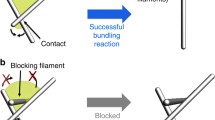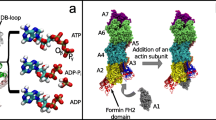Abstract
The regulation of the interactions between the actin binding proteins and the actin filaments are known to affect the cytoskeletal structure of F-actin. We develop a model depicting the formation of actin cytoskeleton, bundles and orthogonal networks, via activation or inactivation of different types of actin binding proteins. It is found that as the actin filament density increases in the cell, a spontaneous tendency to organize into bundles or networks occurs depending on the active actin binding protein concentration. Also, a minute change in the relative binding affinity of the actin binding proteins in the cell may lead to a major change in the actin cytoskeleton. Both the linear stability analysis and the numerical results indicate that the structures formed are highly sensitive to changes in the parameters, in particular to changes in the parameter ϕ, denoting the relative binding affinity and concentration of the actin binding proteins.
Similar content being viewed by others
Literature
Alt, W. 1987. Mathematical models in actin-myosin interaction. InFortschiritte der Zoology, Nature and Function of Cytoskeletal Proteins in Motility and Transport, Band 34, K. E. Wohlfarth-Bottermann (Ed.), pp. 219–230. Stuttgart: Gustav Fisher Verlag.
Alt, W. 1992. Personal communication.
Civelekoglu, G. and A. Mogilner. 1994. The actin tail ofListeria monocytogenes. Submitted.
Cooper, J. A. 1991. The role of actin polymerization in cell motility.Ann. Rev. Physiol. 53, 585–605.
Cooper, J. A., E. L. Buhle, Jr., S. B. Walker, T. Y. Tsong and T. J. Pollard. 1983. Kinetic evidence for a monomer activation step in actin polymerization.Biochemistry 22, 2193–2202.
Dembo, M. 1989. Field theories of the cytoplasm.Com. theor. Biol. 1(3), 159–177.
Edelstein-Keshet, L. and G. B. Ermentrout. 1990. Models for contact mediated pattern formation.J. math. Biol. 29, 33–58.
Harris, H. 1987. Few answers but many questions.Nature 330, 310–311.
Hartwig, J. H. 1992. Mechanisms of actin rearrangements mediating platelet activation.J. Cell. Biol. 118(6), 1421–1442.
Hartwig, J. H. and T. P. Stossel. 1981. Structure of macrophage actin-binding protein molecules in solution and interacting with actin filaments.J. molec. Biol. 145, 563–581.
Hartwig, J. H., J. Tyler and T. P. Stossel. 1980. Actin binding protein promotes the bipolar and perpendicular branching of actin filaments.J. Cell Biol. 87, 841–848.
Hartwig, J. H., M. Thelen, A. Rosen, P. A. Janmey, A. C. Nairn and A. Aderem. 1992. Marcks is an actin filament crosslinking protein regulated by protein kinease C and calcium-calmodulin.Nature 356, 618–622.
Korn, E. D. 1982. Actin polymerization and its regulation by proteins from nonmuscle cells.Physiol. Rev. 62(2), 672–729.
Meulemans, W. and A. De Loof. 1992. Changes in cytoskeletal actin patterns in the malphigian tubules of the fishfly,Sarcophage bullata, during metamorphosis.Int. J. Insect Morphol. Embryol. 21(1), 1–16.
Mogilner, A. and L. Edelstein-Keshet. 1994a. Selecting a common direction: How orientational order can arise from simple contact responses between interacting cells. Submitted.
Mogilner, A. and L. Edelstein-Keshet. 1994b. Spatio-angular order in populations of self-aligning objects: formation of oriented patches. Submitted.
Mossakowska, M., J. Belagyi and H. Strzelecka-Golaszewska. 1988. An EPR study of the rotational dynamics of actins from striated and smooth muscle and their complexes with heavy meromyosin.Eur. J. Biochem. 175, 557–564.
Oster, G. 1989. Cell motility and tissue morphogenesis. InCell Shape: Determinants, Regulation and Regulatory Role, pp. 33–61. New York: Aademic Press.
Oster, G. F. and G. M. Odell. 1984. Mechanics of cytogels. I: oscillations in physarum.Cell Motil. 4, 464–503.
Oster, G., J. D. Murray and G. M. Odell. 1985. The formation of microvilli. InMolecular Determinants of Animal Form, pp. 365–384. New York: Alan R. Liss.
Phillips, L., F. Seperovic, B. A. Cornell, J. A. Barden and C. G. dos Remedios. 1991. Actin dynamics studied by solid-state NMR spectroscopy.Eur. Biophys. J. 19, 147–155.
Pohl, T. 1990. Periodic contraction waves in cytoplasmic extracts. InBiological Motion: Lecture Notes in Biomathematics, Vol. 89, W. Alt and G. Hoffmann (Eds), pp. 85–94. Berlin: Springer.
Pollard, T. D. 1990. Actin.Curr. Opin. Cell Biol. 2, 33–40.
Pollard, T. D. and J. A. Cooper. 1986. Actin and actin-binding proteins. A critical evaluation of mechanisms and functions.Ann. Rev. Biochem. 55, 987–1035.
Pollard, T. D., L. Satterwhite, L. Cisek, J. Corden, M. Sato and P. Maupin. 1990. Actin and myosin biochemistry in relation to cytokinesis.Ann. N.Y. Acad. Sci. 582, 120–130.
Sato, M., W. H. Schwartz and T. D. Pollard. 1987. Dependence of the mechanical properties of actin/α-actinin gels on deformation rate.Nature 325, 828–830.
Sawyer, W. H., A. G. Woodhouse, J. J. Csarnecki and E. Blatt. 1988. Rotational dynamics of actin.Biochemistry 27, 7733–7740.
Sherratt, J. A. and J. Lewis. 1993. Stress induced alignment of actin filaments and the mechanism of cytogel.Bull. math. Biol. 55, 637–654.
Small, J. V., G. Rinnerthaler and H. Hinssen. 1982. Organization of actin meshworks in cultured cells: the leading edge.Cold Spring Harbor Symp. quant. Biol. 46, 599–611.
Stossel, T. P. 1984. Contribution of actin to the structure of the cytoplasmic matrix.J. Cell Biol. 99(1), 15s-21s.
Stossel, T. P. 1990. How cells crawl.Am. Sci. 78, 408–423.
Stossel, T. P., C. Chaponnier, R. M. Ezzel, J. H. Hartwig, P. A. Janmeyet al. 1985. Nonmuscle actin-binding proteins.Ann. Rev. Cell Biol. 1, 353–402.
Theriot, J. A. and T. J. Mitchison. 1992. The rate of actin based motility of intracellularListeria monocytogenes equals the rate of actin polymerization.Nature 357, 257–261.
Thomas, D. D., J. C. Seidel and J. Gergely. 1979. Rotational dynamics of spin-labeled F-actin in the sub-millisecond time range.J. molec. Biol. 132, 257–273.
Tilney, L. G., D. J. DeRosier and M. S. Tilney. 1992a. HowListeria exploits host cell actin to form its own cytoskeleton. I. Formation of a tail and how that tail might be involved in movement.J. Cell Biol. 118(1), 71–81.
Tilney, L. G., D. J. DeRosier and M. S. Tilney. 1992b. HowListeria exploits host cell actin to form its own cytoskeleton. II. Nucleation, actin filament polarity, filament assembly, and evidence for a pointed end capper.J. Cell Biol. 118(1), 83–93.
Vandekerckhove, J. 1990. Actin-binding proteins.Curr. Op. Cell Biol. 2, 41–50.
Way, M. and A. Weeds. 1990. Cytoskeletal ups and downs.Nature 344, 292–294.
Weeds, A. 1982. Actin-binding proteins—regulators of cell architecture and motility.Nature 296, 811–816.
Author information
Authors and Affiliations
Rights and permissions
About this article
Cite this article
Civelekoglu, G., Edelstein-Keshet, L. Modelling the dynamics of F-actin in the cell. Bltn Mathcal Biology 56, 587–616 (1994). https://doi.org/10.1007/BF02460713
Received:
Revised:
Issue Date:
DOI: https://doi.org/10.1007/BF02460713




